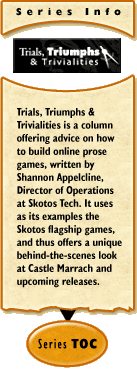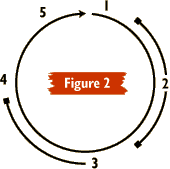
 Trials, Triumphs & Trivialities #76: Trials, Triumphs & Trivialities #76:
The Elements of Good Mythtelling, Part Two: Singular Plot in TheoryJune 13, 2002 - Welcome back to a continuation of our discussion of mythology, only a week later than I'd originally intend. Working on this week's column, I was reminded of a simple fact: it takes a lot more time to research a column than to just spend a few thousand words blathering about whatever happens to be crossing my mind at the time. Well, yeah, duh. If you haven't read my earlier columns on mythology yet, I suggest it. Go ahead, take a moment, I'll wait:
Last week I began a discussion of plot, but probably a different type of plot than you're used to thinking of. I talked about episodic plot which is the big-picture story that connects together all of the smaller pictures in any continuing medium. In Buffy: the Vampire Slayer it's the season-six story of how non-supernatural people are important, or the seven-season arc about Buffy growing up; in Star Wars it's the story of Luke's growth through three movies, or the story of the rise and fall of an empire through six; and, in mythology, it's the story of Hercules' twelve labors, or the story of his entire life. That's episodic plot and this week I want to take a step down, coming closer to individual stories, by talking about singular plots. This is a single episode of Buffy or maybe a two-parter; or one of Star Wars films; or a single event in a hero's life, with a beginning, a middle, and an end. Joseph Campbell, in his seminal book The Hero with a Thousand Faces, offered a generic structure for mythological plots that he called "The Hero's Journey". This week I'm going to explain what that structure is, removing the overly Freudian elements whenever I can. Next week I'm going to offer some examples on using the structure, then give some specific advice for integrating it in online games. The Hero's Journey: A Structure for PlotsStructure is the particular skeleton that you hang singular plots upon. It's a way of organizing your story so that, supposedly, it gives the most dramatic punch. There are numerous plot structures, the most well-known of which is probably the three-act structure outlined by Aristotle. The Hero's Journey structure organizes stories something like this... Part One: Departure The plot begins with hero living out his everyday life within his community. Then, there is a call to adventure. Something appears to break the hero out of his everyday life, for example: a white hart runs across the feasting-day table (King Arthur); or the most beautiful woman in the world is stolen away (The Iliad); or there is word of an upcoming ball (Cinderella). This call is often brought by a herald. Sometimes it is resisted, perhaps multiple times, but the call resounds and eventually the hero must obey it. A hero usually does not set out into the unknown alone. Instead he is aided by a helper or perhaps simply a guide who tends to be supernatural, and thus the first indication of the magical quest that awaits the hero. This helper/guide could be, for example: the greatest magician in the world (King Arthur); a white rabbit (Alice in Wonderland); or a knowledgeable Watcher (Buffy the Vampire Slayer). The helper or guide often equips the hero with talismans of power, for example: stakes, holy water, and crosses (Buffy the Vampire Slayer); a scabbard which protects its holder from bleeding (King Arthur); or potions which can cause one to change size (Alice in Wonderland). Having received supernatural aid, the hero now quests forth until he reaches the edge of his own world, be that world physical, philosophical, or supernatural. However, he must either defeat a guardian at the threshold in order to transit to the Other World, or else face such a beast immediately upon entering the other realm. For example: upon entering a supernatural world hidden within our own One Girl Born in Each Generation might have to fight vampires (Buffy the Vampire Slayer); to enter Hades a hero might have to pay the ferryman his due (Orpheus); or to cross the Aegean Sea a king might have to sacrifice his daughter (Iphigenia). Sometimes the hero might be forced to cross the threshold, not by his own will — often due to death. Campbell offers a number of specific threshold battles which could occur, including: brother battle; dragon battle; dismemberment; crucifixion; abduction; night-sea journey; and wonder journey. In the end the hero finds himself in the belly of the beast, which is to say well-stuck in the Other World. Part Two: Initiation Having crossed into the Other World, a hero must now face any number of trials of the body, heart, mind, and spirit. These could be impossible labors (Hercules); weekly fights with the supernatural (Buffy the Vampire Slayer); or additional obstacles blocking the way, like three-headed dogs (Orpheus). Eventually the hero faces a supreme ordeal which is the greatest of all, and which he barely emerges from victoriously. The goal of a Hero's Journey is, metaphorically, maturity. The hero must grow in some way in order for his quest to be successful. Campbell's book gets a little muddy at this point, because it fills up with Freudian philosophy about mothers and fathers. Working around that, his analyses of the rewards of Hero's Journeys are apt: The meeting with the goddess. The hero meets a female figure who brings him knowledge or love. For example: Orpheus wins back his bride (Orpheus); or the Greeks win back Helen (the Iliad); or Lancelot frees a woman from a boiling bath (King Arthur). Atonement with the father. The hero reconciles himself with his past and looks toward his future. For example: Job understands why his lord has tortured him (the Bible). Apotheosis. The hero gains personal power which makes him greater than he was. For example: Percival is raised up to heaven (King Arthur). The Ultimate Boon. The hero wins some great reward which he will be able to bring back to his people. For example: the Golden Fleece (Jason & the Argonauts); or the herb of immortality (Gilgamesh); or fire (Prometheus). Part Three: Return Having gained maturity, becoming something greater than he was, the hero can now begin his journey back to his own world. There may be temptations which induce the hero to stay in the Other World, and sometimes these temptations may successfully lure him. If not, how he returns to the other world can vary: Emissary. The gods have smiled upon the hero and he now leaves the Other World as their emissary, bringing their word and their boons back to the world in their name. For example: Orpheus returning with his bride to the surface as a boon from the gods (Orpheus). The Magic Flight. Having stolen something from the gods, the hero must flee in terror. He may be chased or obstacles may be placed in his way. For example: chased by Gorgons (Perseus); or chased by Medea (Jason). The hero may be forced to put obstacles in his pursuers' way to win his freedom. Rescue from Without. Sometimes, having accomplished his heroic tasks, a hero needs help to return to his own world. In this case, someone from the outside provides the impetus for his return. For example: the hero is resurrected (Buffy the Vampire Slayer or Osiris or Inanna). In the end, the hero must cross the return threshold in order to return to his own world. There is often a final battle or else a price to be paid afterward. For example: returning from the faerie realm a hero learns 100 years have gone by (many faerie tales); or returned from death a hero can no longer feel (Buffy the Vampire Slayer); or returned from Hades a hero learns she must return for half of every year (Persephone). However, the hero has brought back with him great rewards. Either he has an elixir — some power which he may share with his community — or he has become a master of two worlds — having embodied power within himself. The Hero's Summary
Final NotesIn closing this article, I'd like to make a few references. First, the structure that I ended up following for this set of myth articles — discussing plot, then character, then backstory — is based on the structure of Kimberly Appelcline's excellent introductory articles, The Elements of Good StoryTelling. Second, this is the second time that I've taken a look at the structure of plot in another medium, then applied it to online games. While you're waiting for the next installment, you might want to read my discussions of move plot structure:
As already noted, next week I'm going to take the structure laid out in this week's article and show how it can be concretely used in practice. In 7 days, I promise; I've already done the research. Before I close, though, I'd like to add a little coda to my discussions of mythology and copyright which appeared back in TT&T #71. There, I said that modern copyright was basically killing mythology. To prove that I'm not a voice alone on this issue, I offer the following from Annalee Newitz's column, techsploitation. This is quoted from an article called "Fanfic of the Damned" which appeared in The San Francisco Bay Guardian, June 5-11, 2002: On our copyright-obsessed planet, even characters on a show are trademarks. So are plotlines. Last year a Star Trek fan site (www.bradley.edu/campusorg/psiphi/mov) was served with a cease-and-desist notice from Viacom's attorneys for posting a plot synopsis of the latest Star Trek movie. Even sweet Anne McCaffrey, author of the Dragonriders of Pern series, has sicced her lawyers on people who draw pictures of dragons "inspired" by McCaffrey's work. The penalties for fans who dare to think independent thoughts about the stories mass culture tells them are prohibitive. Is Rodenberry's Star Trek or McCaffrey's Pern likely to enter the mythological worldpool? Not likely while Mickey Mouse holds the creativity of three generations hostage. I'll see you in 7. |
 Putting that all together, we get the following handy summary of the mythological plot structure. Filled bullets show the more necessary elements, open bullets the more optional ones. I've also included a set of five numbers which correspond to a graph of The Hero's Journey which originally appeared in The Elements of Good Storytelling #4,
Putting that all together, we get the following handy summary of the mythological plot structure. Filled bullets show the more necessary elements, open bullets the more optional ones. I've also included a set of five numbers which correspond to a graph of The Hero's Journey which originally appeared in The Elements of Good Storytelling #4,